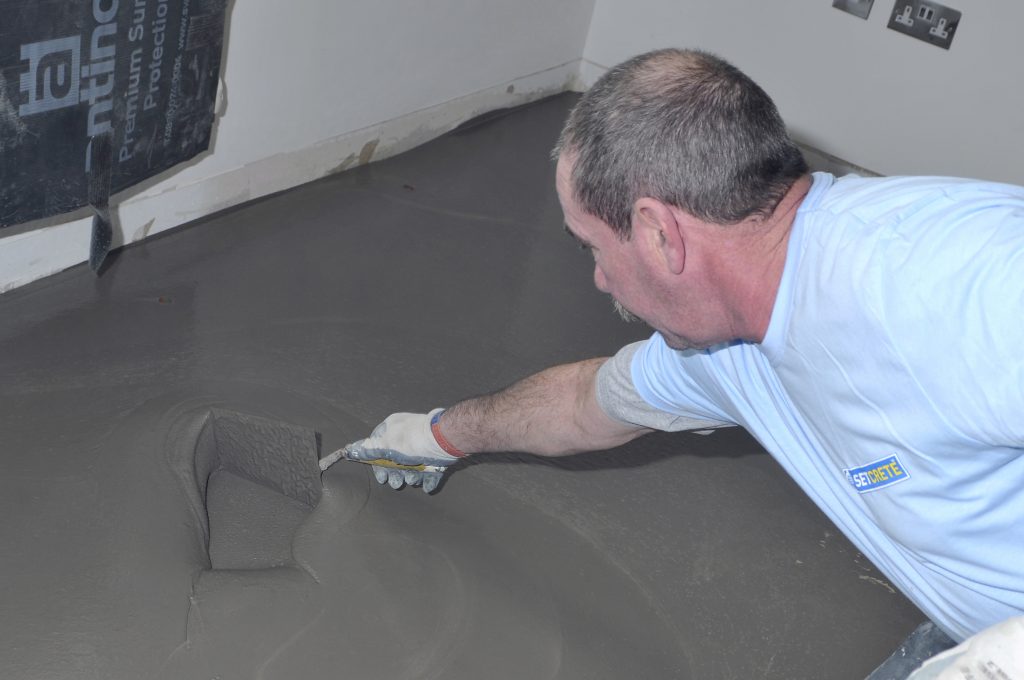Builders faced with levelling up a marked difference in floor height (maybe up to 50mm) between two rooms, for example the floor in a house extension and the floor in the original building or in a situation where an internal wall has been removed, would traditionally opt for a sand/cement screed to build up the lower floor level. While this ‘does the job’, there is a better alternative.
Deep base floor levelling compounds can be installed up to a depth of 50mm in one go and, what’s really impressive, is that they can be walked on as soon as 90 minutes after application. Carpets or ceramic tiles can be installed from only six hours after application. Resilient floorcoverings, such as vinyl, rubber or lino can be installed after 24 hours (although if the thickness is above 10mm, it is recommended that the deep base compound is capped with a thin layer (3mm) of high performance levelling compound once it is ‘walk on hard’ and then left for 24 hours.
In contrast, a sand/cement screed used to level up a floor can take a day or two before it is ready to be walked on and, importantly, will take many more days to naturally dry out before a floor covering can be installed. These screeds will typically dry at a rate of around one day per millimetre depth of screed, which would mean around 50 days for a 50mm screed to become fully dry. The temptation is to proceed with the flooring installation before the screed is fully dry, which is virtually guaranteed to lead to problems.
Moisture menace
Indeed, moisture is such a problem for flooring installations (it is the number one cause of flooring installation failures) that screeds should be checked for the presence of moisture before any work is carried out. This can be done using a handheld moisture meter or, more accurately, using a digital hygrometer. You cannot reliably judge the presence of moisture by smell or touch.
The maximum moisture level, measured in terms of relative humidity (RH), should be 75% RH or 65% if wood flooring is going to be installed.
Excess moisture is more likely to be present if the subfloor was laid before structural damp proof membranes (DPMs) became mandatory in buildings or if it is a newly laid screed and may have high levels of residual construction moisture as outlined above.
If excess moisture levels are detected, a rapid set, liquid damp proof membrane can be applied over the screed, before the deep base levelling compound is installed, to provide a protective moisture barrier. The best performing DPMs will cure in around three hours at 20°C.
If not dealt with, excess moisture can attack adhesives; leading to floorcoverings blistering or becoming detached from the subfloor, it can cause carpets to rot and wood floors to warp, and it provides ideal conditions for mould growth.
Quick and easy
If moisture levels are below the 75% (or 65%) threshold, the deep base levelling compound can be installed immediately, following priming and drying of the appropriate primer. Priming ensures good adhesion between the compound and the substrate, providing a higher quality finish. It also helps to prevent pinholing and unacceptably rapid drying of the levelling compound when installed over absorbent subfloors.
The water-mixed deep base levelling compound is then simply poured onto the area to be raised and allowed to flow into position, requiring only minimal work with a smoothing trowel. The compound will typically have a working time of 20-30 minutes.
Substrate suitability
As well as being suitable for use over sand/cement screeds and concrete, deep base levelling compounds are also suitable for use over non-absorbent subfloors such as ceramics, granolithic, terrazzo, epoxy and polyurethane resins, and ceramic and quarry tiles that are in sound condition and well adhered to the subfloor. They have found widespread popularity in raising floor levels in conservatory extensions and for filling in trenches in floors where an internal wall has been removed to create a more open living space. Furthermore, they can be used over both wired and wet underfloor heating systems.


